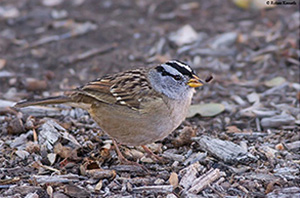Vocal_Dialects |
|
|---|---|


photographs of a Spotted Towhee (top) and a White-crowned Sparrow (bottom) by Rohan Kamath |
Just
as our speech patterns vary regionally, the songs of many
avian species also show geographic variation. For example,
in states and provinces east of the Mississippi, the songs
of Spotted Towhees consist of two introductory notes
followed by a buzzy trill. Songs in the Rocky Mountain
states begin with a single introductory note followed by the
trill, and West Coast populations have dropped the
introductory notes entirely -- their songs are composed of
just the buzzy trill. Although such geographic variation is
quite evident to the human ear, we still recognize the
singer as a Rufous-sided Towhee. The songs of populations often differ markedly on a much smaller geographic scale. Local variants are called dialects. They are commonly found in songbirds with populations restricted to particular habitats and separated from other populations by unsuitable terrain. The separation can be on the order of a mile or so, but in some species it can be much less. Among the White-crowned Sparrow populations of coastal California, distinct dialects may be separated by as little as a few yards in what appears to be essentially continuous habitat! Vocal dialects appear to be learned. Young birds hear the songs sung around their natal territories by their fathers and neighboring males, and acquire the peculiarities of these renditions. Factors that determine the geographic pattern of dialects include |
|
the
accuracy with which the pitch and temporal characteristics
of individual song components are learned, the distance
young males disperse from where they hatch to where they
breed, and the timing of dispersal relative to the sensitive
period for learning. The "why" of dialects, their functional significance, has proven more elusive than the question of how they arise. Many ornithologists have assumed that dialects serve as indicators of genetic adaptation to local conditions. The dialects thus enable females to choose males from their own birth area, who presumably are carrying genes closely adapted to the specific environment in which breeding occurs. In other words, dialects function to promote "positive assortative mating" -- the breeding together of similar individuals. Experimental work with several species has shown that females are more responsive to their own song dialects than to more distant song dialects. Genetic studies of White-crowned Sparrows along the coast of northern California have shown genetic differences between birds of different dialects. But nature is rarely that straightforward. Additional work has shown that females of some species are more responsive to songs of males with dialects other than their own, so that the assumption that a female breeds within the dialect region in which she was hatched is not always warranted. In a series of experiments, paired female White-crowned Sparrows were captured on their territories and injected with the male hormone testosterone (to induce singing). Surprisingly, they sang the song of nearby dialects, rather than their own local dialect. Presumably this indicates that they had chosen to mate with males from "foreign" dialects and had dispersed out of their native dialect region. In addition, reanalysis of the genetic data from the White-crowned Sparrow studies has demonstrated that the results may be attributable to other factors. The data could be interpreted as indicating that environments are as heterogeneous within a dialect region as they are between dialect areas. If so, one might expect to find as much genetic differentiation between groups living in dramatically different habitats within a dialect region as between different dialects. Thus, the adaptive significance of dialects remains to be demonstrated. It may be that no selective force has acted to promote dialects. Instead, dialects may simply be epiphenomena -- that have arisen simply as a consequence of vocal learning -- and have no evolutionary significance. |
|
| SEE:
Vocal Development;
Vocal Functions;
Vocal Copying;
Hybridization. Copyright ® 1988 by Paul R. Ehrlich, David S. Dobkin, and Darryl Wheye. |
|